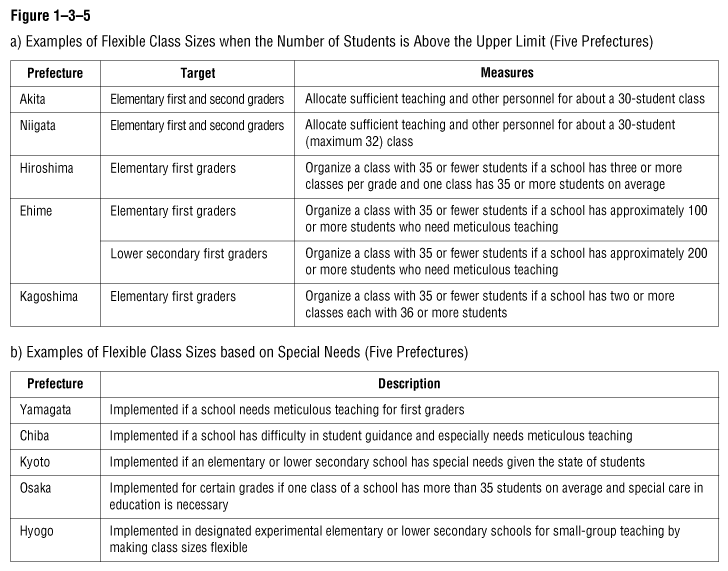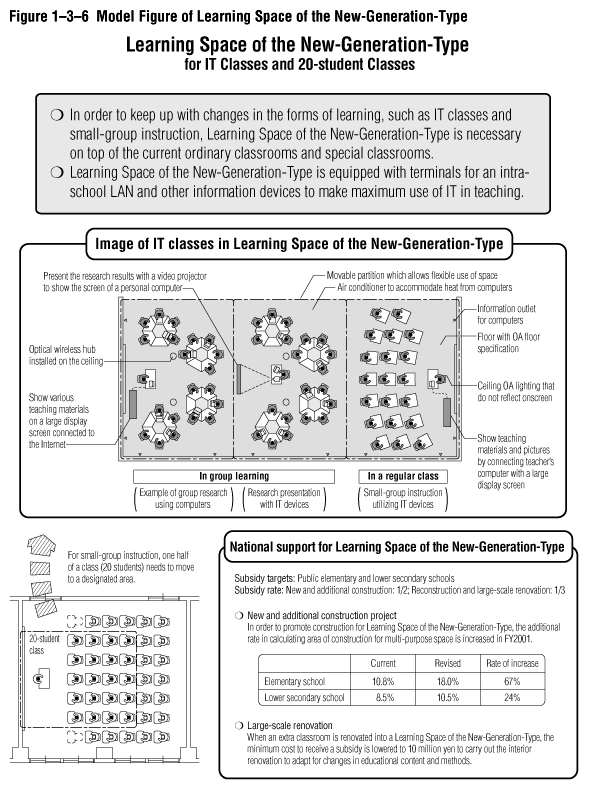| Home > Policy > White Paper, Notice, Announcement > White Paper > Japanese Government Policies in Education, Culture, Sports, Science and Technology 2001 >Chapter3 Section2.3 | ||
The realization of the aim of the new Courses of Study requires: {1} arrangements to properly evaluate the level of student's learning and curriculum's implementation in each school; and {1} an educational environment including staffing levels of teaching and other personnel and facilities to enable the promotion of individually targeted teaching such as small-group education and class assignments according to one's degree of proficiency.
In order to properly assess the state of a student's learning and the curriculum's implementation, it is necessary to establish arrangements to evaluate: {1} the state of a student's learning on an individual basis; and {2} the state of achievement of the Courses of Study's objectives across the nation, and of the curriculum's implementation.
As for {1} above, in addition to further emphasizing evaluation based on how far the objectives provided by the Courses of Study have been achieved (so-called absolute evaluation), it is necessary to develop objective criteria and methods to evaluate student learning. In 2001, MEXT thus advised prefectural boards of education and municipal boards of education on improvements that should be made in the cumulative record of education for the state of a student's learning. Specific items for improvement are as follows:
Along with the improvement of the cumulative record of education, each school needs to conduct a study to compile evaluation criteria for better objectivity. Boards of education, on the other hand, need to study and develop concrete evaluation criteria to support each school's efforts.
At the national level, the Center of Curriculum Development at the National Institute for Educational Policy Research is currently engaged in the development of evaluation criteria to support efforts by schools and boards of education.
With respect to {2} above, in order to perceive the state of achievement of the Courses of Study's objectives across the nation, and the state of the curriculum's implementation, nationwide surveys on academic ability will be conducted by the National Institute for Educational Policy Research of Japan in FY2001 for elementary and lower secondary schools and in FY2002 and FY2003 for upper secondary schools, as stipulated in the Education Reform Plan for the 21st Century.
It is also important for each school to self-monitor and self-evaluate the ability of its students and to improve teaching methods based on the results of the planned nationwide survey on academic ability under the new Courses of Study.
The Center of Curriculum Development at the National Institute for Educational Policy Research is currently studying how each school should check and evaluate the ability of its students.
Steady implementation of these measures is expected to contribute to improving the basic academic ability of students.
Meticulous, individually-targeted teaching such as small-group guidance and class assignments according to one's degree of proficiency requires increasing the staffing level of teachers and other personnel. As pointed out in the Education Reform Plan for the 21st Century, necessary measures will be taken with a five-year program from FY2001 to FY2005. More specifically, the Seventh Plan to Improve Fixed Numbers of Education Personnel at Public Compulsory Schools has started, and it plans to increase school teaching staff by 26,900 for compulsory schools from the standpoint of supporting each school's concrete measures, including small-group (about 20 students) education for certain subjects, which aims at improving children's basic academic ability and making teaching more meticulous. As for upper secondary schools, the Sixth Plan to Improve Fixed Numbers of Education Personnel at Public Compulsory Schools has started, and it plans to increase teaching staff by 7,008 with the view to diversify upper secondary education. In this scheme, special consideration can be given to schools that employ unique teaching methods such as unified lower and upper secondary school education, integrated courses and credit-based upper-secondary school systems. Necessary revisions of laws have already made for both plans.
Concerning class sizes, prefectural boards of education are now allowed to set up exceptional standards to have classes lower than national standards of 40 students if there are special needs for such a smaller class size depending on certain situations of students since FY2001. Several prefectures have put this system of flexible class size into practice ( Figure 1-3-5 ).

Furthermore, new learning space that is suited to individually targeted meticulous education like 20-student class education and IT education (Learning Space of the New-Generation-Type) has been newly created, and an intra-school local area network (LAN) and personal computers in classrooms have been newly provided ( Figure 1-3-6 ).

|
- Example of proficiency-dependent teaching - Aburakawa Lower Secondary School of Aomori City Aburakawa Lower Secondary School of Aomori City introduced so-called proficiency-dependent teaching, in addition to regular class teaching, where students are divided into study groups according to their degree of understanding in the second semester of FY1999. The proficiency-dependent learning there concerns all third grade students, and divides them into groups based on their understanding of five subjects: Japanese language, mathematics, English, social studies and science. The members of each group are reshuffled four times a year to reflect students' abilities and accommodate their wishes. Aburakawa Lower Secondary School has been making efforts to enhance its relationship with the local community because it thinks that understanding the local community is necessary for the smooth implementation of proficiency-dependent teaching. For instance, it actively invites local residents to the school and has its students take part in local volunteer activities. - Example of Subject-based Teacher Assignment in Elementary Schools - Hamamatsu City, Shizuoka Hamamatsu City, since FY2000, has adopted subject-based teacher assignments along with class-based teacher assignments in upper grades of all elementary schools to make good use of the ability of teachers who are skilled in a particular subject. Hikiuma Elementary School of Hamamatsu City, for example, has introduced subject-based teacher assignments for calligraphy, social studies, science, physical education, music, art and home economics in the fourth, fifth and sixth grades, although the subjects taught by a subject-based teacher have been different depending on the grade and class due to the limited number of teachers available. Oiwake Elementary School in Hamamatsu City has employed subject-based teacher assignments mainly in middle grades and above to take advantage of the specialty of each teacher. With this, the school aims at creating class lessons that can promote students' individuality by taking a good look at each student and his or her strong points. As for middle grades and above, subjects to which this type of teacher assignment is applied are Japanese language, calligraphy, arithmetic, science, physical education, music, art, life environmental studies and home economics. Even in lower grades, calligraphy and physical education are taught by a teacher in charge. |
|
The report on appropriate class size to maximize educational effects (Results of Study on the Effect of Class Size on Students' Learning, Academic Ability and Attitude by the National Institute for Educational Policy Research [June 2001]) finds that higher scores in scholastic tests and more desirable situations concerning learning and other class activities are observed in a 20 or fewer-student class than in a class comprised of more than 20 students, although the differences are not so significant. Judging from this report, the promotion of the improvement plan on teaching staff levels that makes small-group (about 20 students) instruction possible is expected to contribute to improving students' academic ability and fostering desirable attitudes. |
| Back To Top | MEXT HOME |